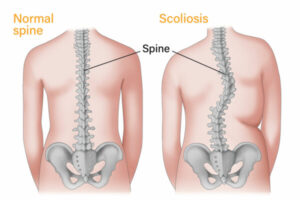Introduction
Scoliosis is a medical condition characterized by an abnormal sideways curvature of the spine. It can occur during growth spurts in childhood or adolescence, or it can be caused by underlying conditions. Scoliosis can range from mild to severe and may require treatment to manage symptoms and prevent further progression.

Symptoms
The most common symptom of scoliosis is an abnormal curvature of the spine. Other symptoms may include:
- Uneven shoulder or hip levels.
- Asymmetrical waistline or rib cage.
- One shoulder blade appearing more prominent than the other.
- Back pain or discomfort, particularly after prolonged periods of standing or sitting.
- Fatigue or muscle stiffness.
Diagnosis
Diagnosing scoliosis involves a thorough examination by healthcare professionals, typically orthopedic specialists or spine surgeons. They will evaluate the curvature of the spine using physical examination techniques, such as the Adam’s Forward Bend Test. Imaging tests, such as X-rays or MRI scans, may be performed to determine the severity and extent of the curvature. Additionally, the healthcare provider may measure the degree of the curvature using a system called the Cobb angle.
Treatment
The treatment for scoliosis depends on various factors, including the severity of the curvature, the age of the individual, and the potential for further progression. Treatment options may include:
Observation: In cases of mild scoliosis with minimal progression, regular monitoring may be recommended, especially if the individual is still growing.
Bracing: For moderate scoliosis or if the individual is still growing, bracing may be prescribed. The brace helps slow down or prevent further progression of the curvature by providing external support to the spine.
Physical Therapy and Exercises: Certain exercises and physical therapy techniques can help improve posture, strengthen muscles, and maintain flexibility. These exercises are often tailored to the individual’s specific curvature and overall condition.
Surgical Intervention: In severe cases of scoliosis or when other treatments have been unsuccessful, surgery may be recommended. The surgery aims to straighten and stabilize the spine using techniques such as spinal fusion or the insertion of rods or screws.
Lifestyle Changes
Living with scoliosis may involve making certain lifestyle adjustments:
Maintaining Good Posture: Practicing good posture and body mechanics can help minimize discomfort and prevent additional strain on the spine.
Regular Exercise: Engaging in regular physical activity, with guidance from healthcare professionals, can help strengthen the muscles that support the spine and improve overall fitness.
Pain Management: If scoliosis causes back pain or discomfort, various pain management techniques, such as applying heat or cold packs, taking over-the-counter pain relievers, or receiving physical therapy, may help alleviate symptoms.
Emotional Support: Living with scoliosis can have emotional and psychological impacts. Seeking support from loved ones, joining support groups, or engaging in counseling can provide valuable emotional support and coping strategies.
Regular Monitoring: Regular check-ups with healthcare professionals are important to monitor the progression of scoliosis, evaluate treatment effectiveness, and address any new concerns.
Remember, the management of scoliosis is individualized, and healthcare professionals will tailor the treatment plan based on the specific needs and circumstances of each individual. With appropriate care, support, and lifestyle adjustments, individuals with scoliosis can lead active and fulfilling lives.







